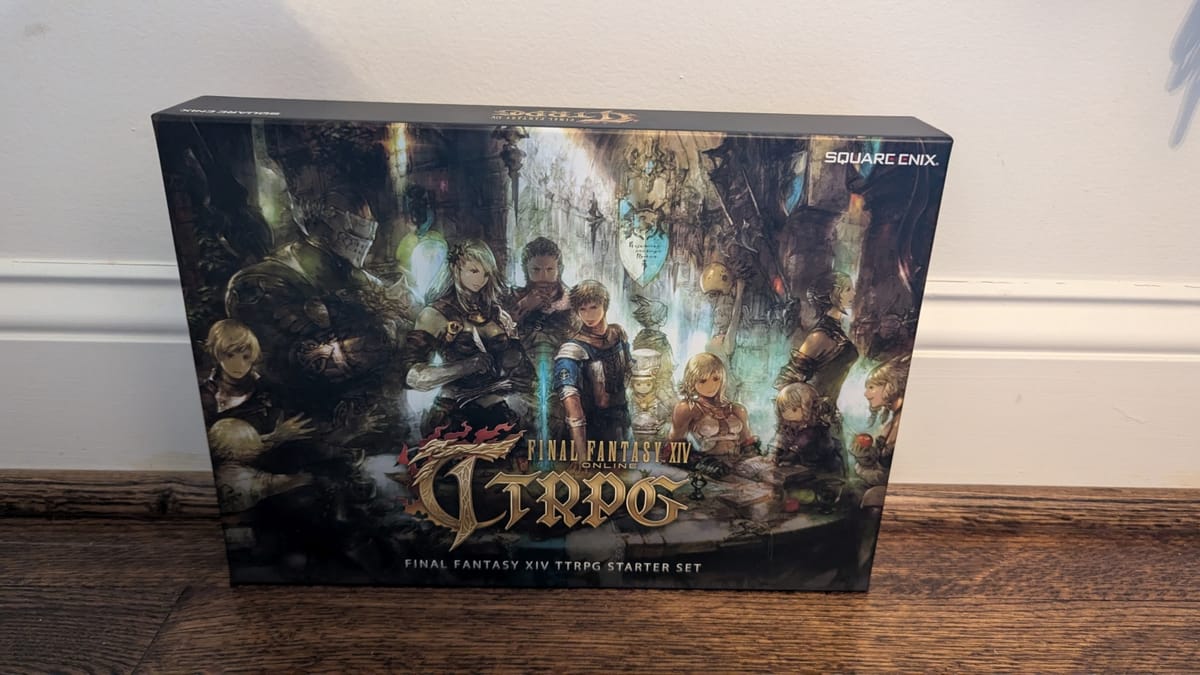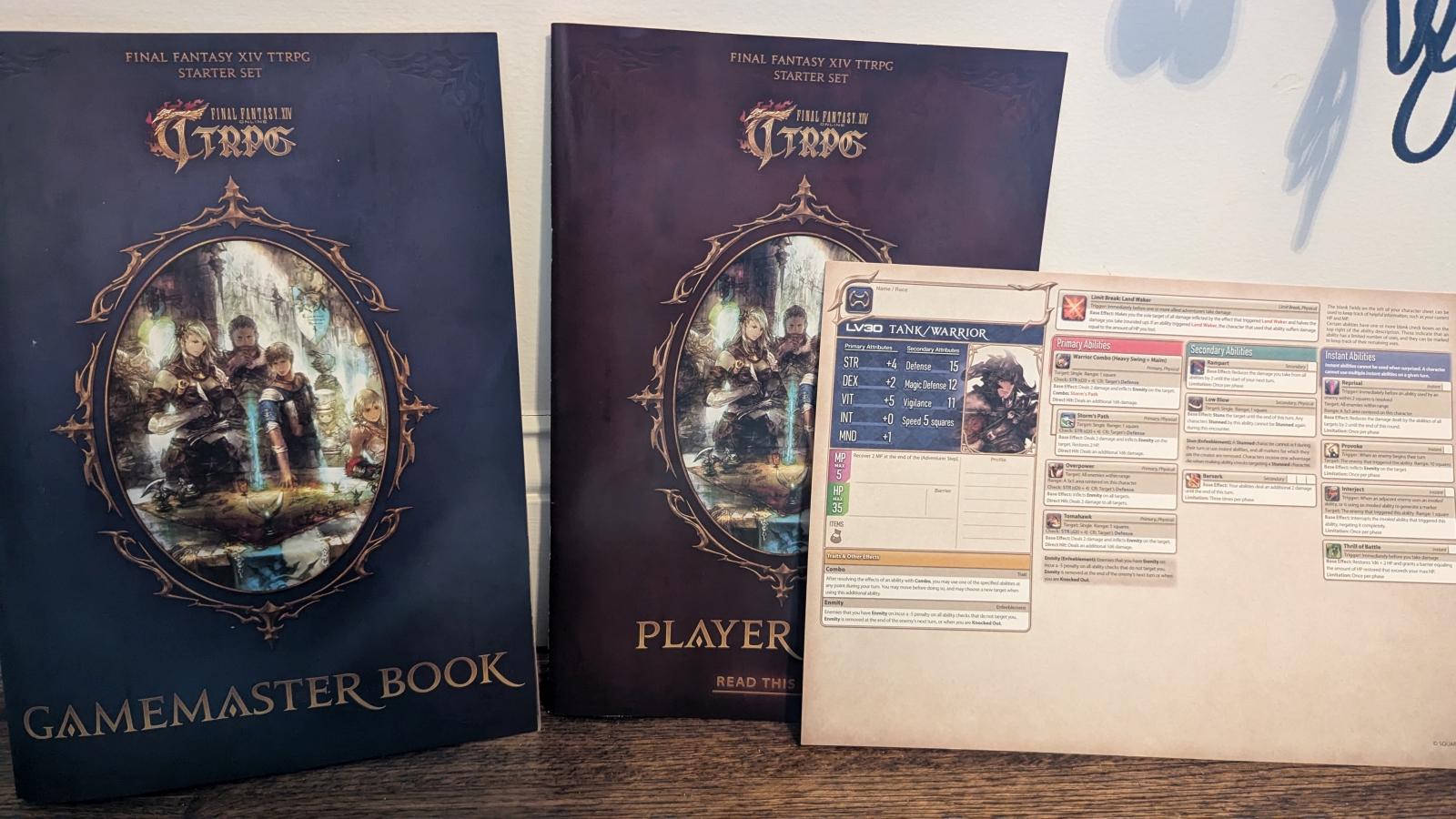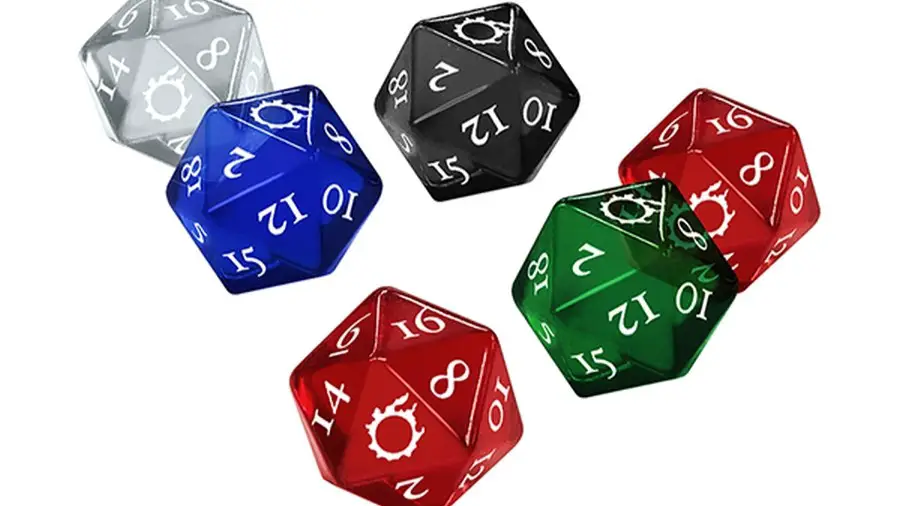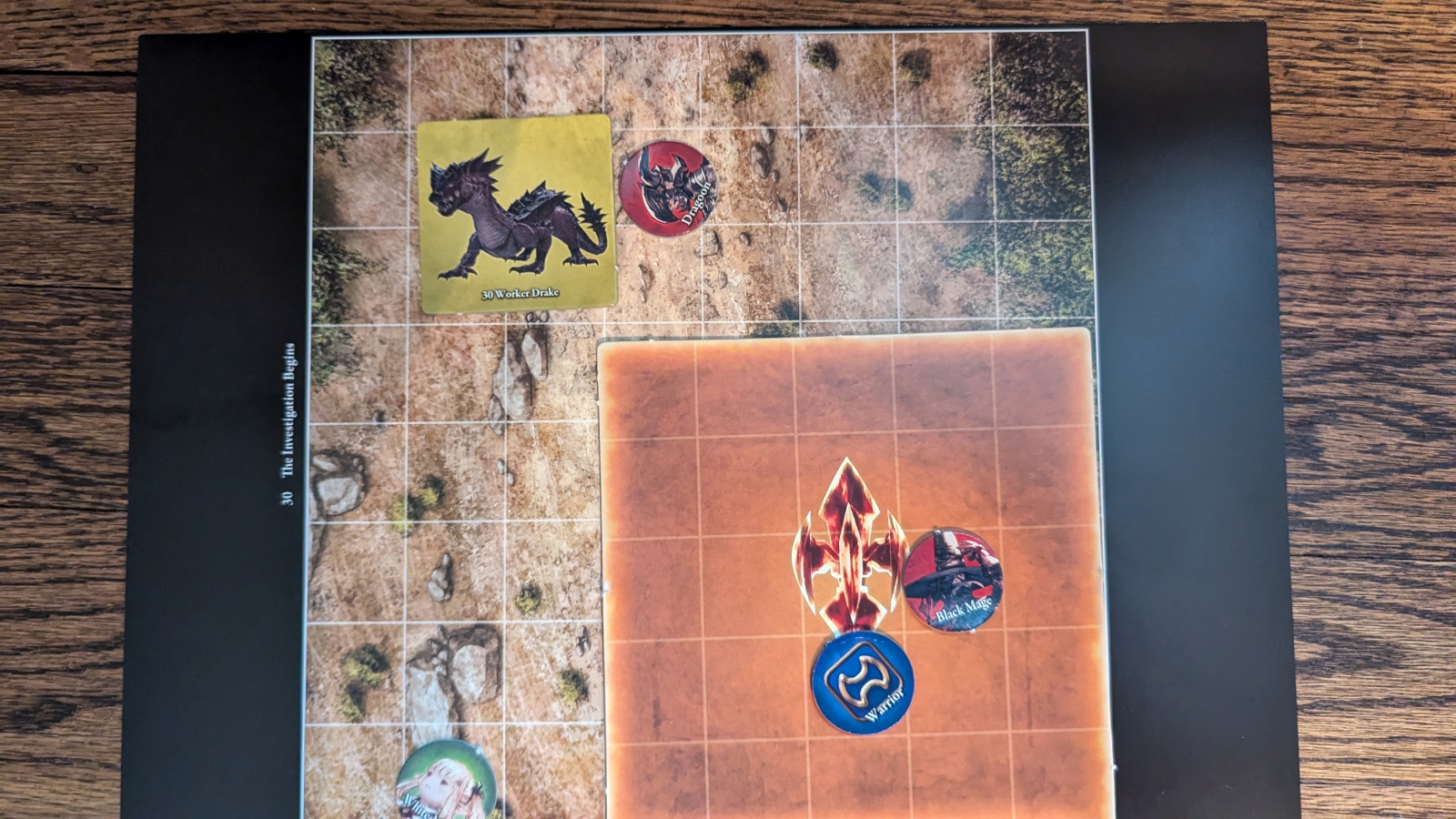
I don’t get to play a lot of TTRPGs, or any if I’m being honest, but I do know alot about them and I also know a lot about Final Fantasy XIV, so when the two collided naturally I jumped at the chance to cover it. While I’m familiar with the likes of Dungeons & Dragons and Pathfinder, I was surprised to find the Final Fantasy XIV TTRPG succeeded in recreating how the MMORPG feels to play. That framework does introduce some rigidity and complexity into the system, but makes it feel incredibly unique among its contemporaries.
Currently, only the Starter Set for the Final Fantasy XIV TTRPG is available, with more books coming down the road, like a Player’s and a GM’s handbooks as well as more adventure books. While the Starter Set contains everything you need to start playing (hence the name), it is a bit disappointing that it only has four playable jobs out of the MMO’s now twenty one. As such, it feels very “A Realm Reborn” if you catch my meaning. This is a base to build off of, you just have to be patient.
That doesn’t mean you shouldn’t play the Starter Set if you’re still interested though. Fans of the MMO will find a lot to like here and TTRPG players can experience a fresh and interesting system somewhat reminiscent of D&D 4th Edition. For those completely new to tabletop, there’s even a handy comic accompanying an example game to teach you the most basic of basics. Everything starts at character creation. While the books don’t list any of the playable races, they are only cosmetic and have no mechanical effects. A Lalafell Warrior will be just as effective as a Hrothgar Warrior, so pick whatever takes your fancy. The four jobs you can choose from are the following: Warrior, Dragoon, Black Mage, and White Mage. It’s unknown how many jobs will become available in later books. Scenarios within the book all expect a light party of that configuration to tackle them, though there are rules if you have fewer players. Player-controlled Chocobos will accompany the party if you’re missing any roles, which is both adorable and handy.

Once you’ve made your character, or adventurer, it’s time to embark on an adventure, or scenario. The included GM’s Guide includes three of them at levels 30, 40, and 50. There’s no real character progression within a scenario, instead adventurers’ levels are “synched” to the scenario. It’s a bit strange that there’s no leveling, acquiring new equipment, or even managing money, but that could just be a quirk of this Starter Set. As it is now, this system lacks much interaction between roleplaying and combat, aside from greatly encouraging the rule of cool in terms of play philosophy. In the future I would like to see something resembling D&D’s magic items, like a talking sword that gives you a hint on how to defeat your enemy, for a rudimentary example.
The initial scenario begins in Ul’dah’s Quicksand, where Momodi approaches the party and asks them to find a shipment of crystals that was stolen in an ambush north of the city. This leads them to interact with a few NPCs, investigate various scenes, and battle enemies. Reading through the scenario, it does strike me as very ridgid without much room for deviation. For example, if the adventurers refuse Momodi’s quest the book tells the GM to remind the players that they are here to actually play the game. It certainly feels like baby’s first adventure, with specific steps along the way as well as boxes of cutscene text the players are not allowed to interrupt. Since this is the Starter Set, I imagine it’s structured this way to get everyone involved used to the game’s mechanics, but it does feel like it’s missing the RPG part of TTRPG. Adding in a section or two where the players are encouraged to embody their characters would go a long way towards facilitating roleplaying, as previous sections of the book included. As a side note, this scenario takes place shortly before the Warrior of Light battles Ifrit, and I have to wonder why the TTRPG still needs to follow alongside the MMO. I’m sure players would rather battle Ifrit themselves, and it’s strange to have that take place off screen. Maybe the core rulebooks will allow players to become Warriors of Light themselves?
As the players investigate, they’ll occasionally be asked to make checks using their characters’ stats and the included dice. These are pretty standard for TTRPGs, with a player adding their bonus for whatever stat the check is measuring to the roll of a D20. What’s nice is that the scenario lays out what happens if the player fails, succeeds, and even reaches a certain threshold above success. This allows the adventure to continue rather than each player trying their hand at the check in turn until they succeed. Success or failure still has consequences, for example if the party fails a stealth check they’ll enter the next combat encounter surprised. This is where the brisk pace really works to the game’s advantage.

Eventually, the party will enter a combat encounter, which feels a lot like playing the MMO the game is based off of. Enemies have set patterns of attacks they’ll loop through, including placing down area of effect moves that the party needs to move out of to avoid on the battlefield grid. Players have combos, buffs, and damage over time effects they can place on enemies. When combat begins, the GM takes out one of the included grids which represents the battlefield and places enemies according to the scenario. Players have a portion of the grid they can place their character tokens on, for example the Warrior can be in the front row while a Black Mage is further to the back. Players then decide what order they’ll take action in, and combat begins in earnest.
The player’s turns consist of three phases: Adventurer Step, a Primary Action, and a Secondary action. These can be done in any order, for example an adventurer could take half of their movement, use a secondary action, use the rest of their movement, and then take a primary action. Instead of moving, a player can also choose to Focus and perform two secondary actions in a single turn. Primary abilities include things like the Dragoon’s True Thrust combo or Jump, while secondary abilities such as Lance Charge will allow the user to deal an additional 2 damage with attacks until the end of the turn. Numbers are generally kept small, which is helpful. Once a character’s turn is finished, they resolve any effects such as MP recovery and move on to the next person in the order.
What makes this system really interesting are instant abilities, which can be triggered at any time, even during an enemy’s action, according to the ability’s trigger. For example, at the end of any combatant’s turn, a Black Mage can use Swiftcast to immediately cast one of their magic spells. Limit Breaks are included in this ability category, though there are more limitations on LB’s than other instant abilities. When the GM specifies LBs are available in the encounter, only three out of four members of the party can use their Limit Breaks. Still, instant abilities keep things active and force the players to strategize on the fly.

As mentioned earlier, enemies follow a set strategy of attacks on a loop and some foes will place AoEs on the battlefield. These are represented by cardboard tokens denoting the attack’s boundaries. Players need to move out of this range or suffer the effects of the attack once it resolves – just like the MMO. There’s even a stack marker token, in which players need to move into the attack to disperse the damage amongst themselves. Again, this is very cool to see recreated in tabletop, and keeps things active, rather than mages always staying as far away from enemies as possible. Combat definitely is the best part of this system, as it uses the game’s relative rigidity to its advantage. The game even encourages roleplay here, and tells the GM to give a player advantage if they do something creative.
There are a lot of rules to keep track of, but there are several reference guides to help with that. The player’s and GM’s books have references on their backs and even the inside of the box top has a guide. The game also includes a strategy guide for each job which, of course, has another rules reference on its reverse. If someone doesn’t have the starter system, they can even visit the website to get an abridged version of the rules. This system really makes it as easy as possible to learn and keep track of, and I hope this design trend continues with the core rules. Of course, that would become a bit more difficult if the system gets less rigid as I hope it will, but it’s well worth the effort.
Finally, a note on the materials included, because there’s actually quite a bit. In the box, you get 16 dice (6 D20s and 10 D6s), 12 premade adventurer sheets (4 for each job at levels 30, 40, and 50), the Gamemaster Book, the Player Book, 4 rules summary or strategy sheets, 4 sheets of markers and character tokens, and finally 3 encounter maps. For a Starter Set, none of it feels cheap thankfully, the dice even have fonts from the MMO on them with the 20 being represented by the game’s meteor logo. The art is mostly recycled from the game as well, with scenarios even using 3D models and area maps ripped straight out of the MMO. (There’s even a cameo from Yoshi P’s character.) I’d certainly prefer 2D artwork, but it’s still a cute way to connect the game and tabletop.
Final Fantasy XIV TTRPG Starter Set
Great
Final Fantasy XIV TTRPG’s Starter Set holds a lot of promise. The system is incredibly novel, perfectly translating MMO mechanics into tabletop, yet it doesn’t provide much room for deviation from its written scenarios. This is a great base to build off of, but whether it can reach its full potential remains to be seen.
Pros
- Various teaching tools and reference guides
- Combat is fast and engaging
- Includes absolutely everything you need to play and then some
Cons
- Very rigid
- Only four jobs to play
- No character progression mid-scenario
